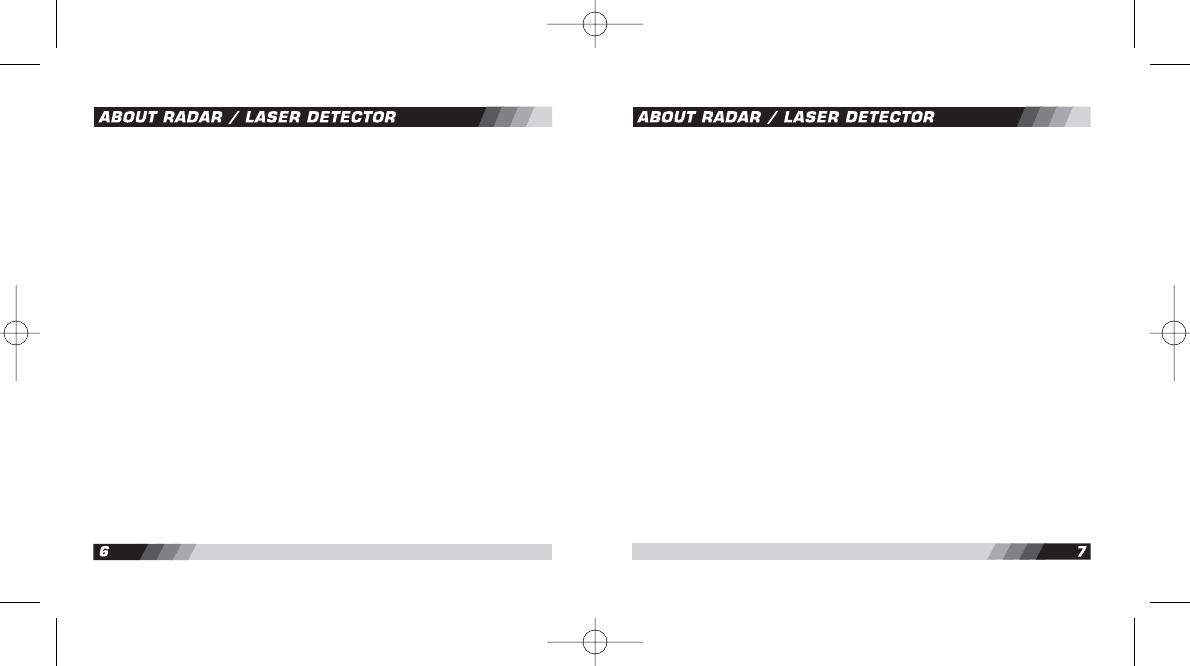
RadarHAWK™ SBIII - Page 9
Until the mid-1970’s, X band (10.50~10.55 GHz) was the only frequency used by most police radar devices.
Early radar detectors needed only to listen for X band radar. But in 1976 police radar devices using K band
(24.05~24.25 GHz) were introduced, leading to the development of the rst dual band detectors able to
receive both frequencies (X and K).
Then, in 1987, a proliferation of police radar devices using KA band frequencies began with the introduction
of photo radar (34.3 GHz), followed by the Stalker (34.2~35.2 GHz) in 1991 and the BEE 36A (33.4~34.4
GHz) in 1992. The introduction of KA band photo radar (34.3 GHz) led to the development of tri-band
detectors able to detect X, K, and a small portion of KA band. A fourth category of “wide-band” radar
detectors capable of detecting X, K, and wide KA (34.2~35.2 GHz) bands reached the market following the
introduction of Stalker radar.
Finally, in response to the BEE 36A, a new generation of “superwide-band” radar detectors was developed.
They detect all police radar devices operating on X, K, and superwide KA (33.4~36.0 GHz) bands. All
RadarHAWK™ radar/laser detectors are superwide band receivers. When radar detectors proved easily
capable of detecting radar from miles away, radar device manufacturers responded by developing
“instant-on radar.” In the instant-on mode, the radar’s transmitter is placed on hold, ready to re but not yet
producing a signal for detectors to hear. The ocer waits until his target is very close, releases the radar
from stand-by mode, and gets a speed reading within a second or so.
In this situation, no detector can oer much warning. But the RadarHAWK™ SBIII is designed to display
“INSTANT” when an instant-on signal is detected, followed by the name of the detected radar band. When
an “INSTANT” alert is displayed, we highly recommend that you promptly reduce your speed if you’re driving
faster than the speed limit.
Laser devices transmit an invisible light beam at a frequency (more accurately a “wavelength”) of 904
nanometers. A nanometer is how a light wavelength is measured. Dierent laser devices operate at
dierent light pulse rates and some manufacturers call them “bands.” All RadarHAWK™ radar/laser
detectors can detect all current laser devices in use.
Less than 1,000 laser devices are in service in 45 states at present. Most are used by city police on urban
multi-lane roadways. The use of laser devices for speed monitoring is expected to increase, but will remain
limited due to their high cost and limited attractiveness to agencies that favor the convenience of
conventional moving radar. Currently, laser guns account for less than 5% of the total number of speed
monitoring devices (radar and laser) sold in the U.S. annually; during the next ve years, this gure is
expected to remain under 8%. Laser devices will likely be in service in every state within a few years.
Laser devices can measure the speed of a target vehicle only when it is up to 1,500 feet away in line of sight.
This means that when the “LASER” alert is displayed, the speed monitoring system is nearby. When a
“LASER” alert is displayed, we highly recommend that you promptly reduce your speed if you’re driving faster
than the speed limit.
v.051707
Laser DevicesRadar Devices


















